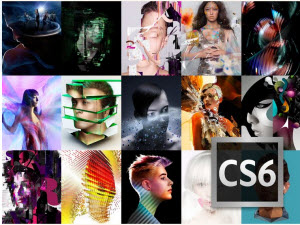Build-Your-Own "Ultimate" Adobe Photoshop CS6 PC

Without a doubt, the single most-requested feature here on Hardware 2.0 in the 'Build-Your-Own PC' category is for an "Ultimate" Photoshop system. Now that Adobe has officially launched Photoshop CS6, it's time to take a look at this new release and prepare a hardware package that does it justice.

Well, here it is, a guide to building your "Ultimate" Photoshop CS6 system.
Personally, I'm not much of a Photoshop user, and most of my "art" ends up looking like the 4chan Rage Guy, so please don't ask me any Photoshop-related questions!
While I'm specifically looking at a system suited to Photoshop CS6, this build will work equally well for any of the big Adobe products, such as Premiere Pro CS6 or even the 'full' Master Collection CS6 package.
To build the "Ultimate" Photoshop system you will need to choose four components carefully. These are:
- A fast, quad-core processor
- Lots of RAM
- Lots of big, fast hard drives
- A graphics card that supports GPU-acceleration found in Photoshop CS6
Let's take a look at these four components in more detail.
Processor
When it comes to Photoshop, there are three CPU-related facts that you have to accept. Intel CPUs trump AMD silicon, speed of the CPU matters, and pushing the cores beyond four doesn't have a huge impact on performance. Here's a benchmark to support all the above statements, and based on my testing these conclusions are just as applicable to Photoshop CS6 as they were to CS5 or 5.5. AMD makes some good CPUs, but for Photoshop you should be looking at Intel processors.So, we're going to start building this Photoshop system by putting an Intel Core i7 at its heart. I recommend the excellent 3.6GHz Core i7-3820 CPU (which turbo-boosts up to 3.8GHz), a part that will set you back about $310.
RAM
You need RAM, and lots of it. Consider 8GB an absolute minimum, and take that to 12GB or 16GB if your motherboard allows. There's not need to get fancy or fast RAM aimed at gaming systems for this build. In fact, you're better off sticking to the quality desktop RAM from reputable vendors.Stick with RAM from Crucial or Kingston and you won't go wrong. Not only will you get a quality, stable product, but these companies offer excellent warranties if you do end up with a bad stick of RAM. This RAM also works out a lot cheaper than the stuff aimed at gamers.
Storage
A Photoshop system needs masses of storage. This is not just because the application itself is huge, or because the output can be massive. It's because in order to get the best from Photoshop you need multiple drives, with each one dedicated to handling a specific task.Ideally, you need four drives. One for the OS, one for the application, one for your output files, and one to act as a "scratch disk." A "scratch disk" is what Adobe calls using a portion of a hard drive as virtual memory. You can get away with fewer disks, for example two disks -- one for Windows and the applications, the other to ask as storage and a "scratch disk" -- but it's far ideal. Trying to run everything on a single disk is best avoided as it's going to create a significant performance bottlenecks.
Since this is an "Ultimate" system, I'm going to recommend that you use four disks. You'll need two large hard disk drives (HDD), and two fast solid state drives (SSD). You'll install Windows onto one of the hard disk drives, and Photoshop onto the other hard drive. Then you'll use the one of the solid state drives for your output files, and the other as a "scratch disk." This setup gives you the best possible storage performance, eliminating a number of potential bottlenecks.
It's worth noting that you don't need big solid state drives for this build because they're only used for short-term storage. Once you're done with a project, it's a good idea to move the files to a hard disk drive where the cost-per-gigabyte is much lower.
Graphics card
Photoshop CS6 features a new Mercury Graphics Engine, and this comes equipped with a number of GPU-accelerated tools, including blur effects, liquify effects, and adaptive wide-angle effects. To make use of these GPU-accelerated tools you will need a system kitted out with a graphics card from the NVIDIA Quadro lineup, something you won't find in a standard system.At the high-end these Quadro graphics cards become super expensive, with a Quadro 6000 setting you back $4,000. Thankfully, you don't need a high-end card to power the new features found in Photoshop CS6 and we can make do with something more modest, such as the Quadro 2000.
Putting it all together
OK, let's put this all together into a complete system. Here's a complete list of components (including case and operating system):- CPU: Intel Core i7-3820 3.6GHz - $310
- Motherboard: ASRock X79 Extreme6 - $250
- RAM: 16GB kit (4GBx4), Ballistix 240-pin DIMM, DDR3 PC3-12800- $105
- HDD: 2 x Western Digital Caviar Green WD30EZRX 3TB ($180 each) - $360
- SSD: 2 x Corsair Force Series 3 CSSD-F120GB3A-BK 2.5" 120GB SATA III ($150 each) - $300
- Graphics card: PNY VCQ2000D-PB Quadro 2000D 1GB - $410
- Optical drive: LG WH12LS39 12X Blu-ray Burner - $80
- Power supply unit: CORSAIR Enthusiast Series TX750 V2 750W power supply unit - $105
- Case: Thermaltake V4 Black Edition chassis - $50
- Operating system: Microsoft Windows 7 Professional SP1 64-bit - $130
Total price: $2,100
Once you've built this system I recommend giving it a thorough stress-test to shakeout any problems before you start working on it. Adobe CS6 applications are incredibly demanding and will uncover even the smallest flaw in your system. Better to find any problems before putting the system into a production environment.
Image credit: Adobe.
Related: